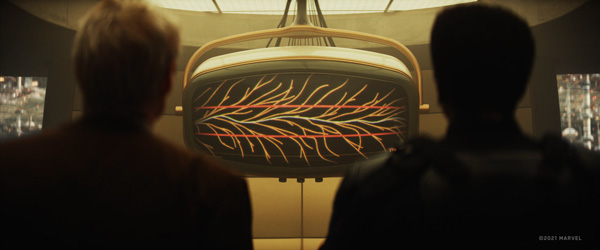
Cantina Creative designed and animated many of the fascinating objects, graphics and devices that populate the worlds and screens of Marvel’s TV series ‘Loki’. The show continues the story of Loki, the God of Mischief, after the events of ‘Avengers: Endgame’. Streaming on Disney+, ‘Loki’ is the 17th Marvel project that the Cantina Creative team has worked on so far.
The Time Variance Authority (TVA) has accused Loki of acting as a ‘variant’ – someone who disrupts the flow of the Sacred Timeline – and recruits him, presumably to put to put things right and help them protect the Timeline. But along the way, he encounters several unexpected versions of himself, some friendlier than others, and discovers that the TVA isn’t what it at first appeared to be.
Cantina Creative Design Supervisor Andrew Hawryluk, VFX Supervisor Tony Lupoi and Producer Donna Cullen worked with the director Kate Herron, Marvel Studios’ VFX Supervisors Dan DeLeeuw and David Allen, and VFX Producer Allison Paul to deliver 172 shots in 33 sequences over six episodes of ‘Loki’.
It’s About Time
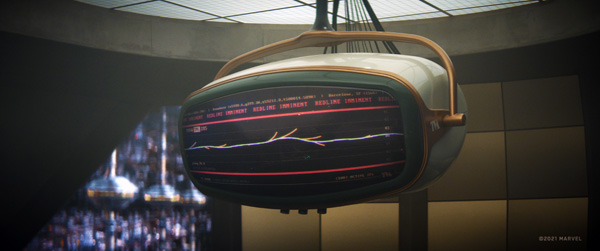
The Sacred Timeline
As Cantina launched into the project, Marvel supplied them with previz, concept art and creative direction. Not surprisingly, much of their work related to time travel, a major feature of the story. Stephen Lawes, Cantina co-founder and creative director, said, “We were initially contracted to design and animate numerous device screens and monitors that would play a key role in helping fans follow the show’s complex time-travel story over several episodes.
“These included the TemPad handheld devices that the TVA’s henchmen, the Minutemen, use to detect deviations from the Sacred Timeline. TemPads display critical diagnostic information and graphics, ranging from locations and time periods to threat levels, and give them the ability to travel in time. We also created content that appears on numerous monitors and Chronomonitors, situated throughout the TVA command centre, that visually display the actual Timeline.
The Cantina Creative team occupies a niche position in film and TV production by focussing on design and motion graphics in VFX. Typically, Cantina’s work is based on the project’s production design, working between the Production Designer and the Director. But ‘Loki’ was different, requiring them to liaise more often with the visual effects team.
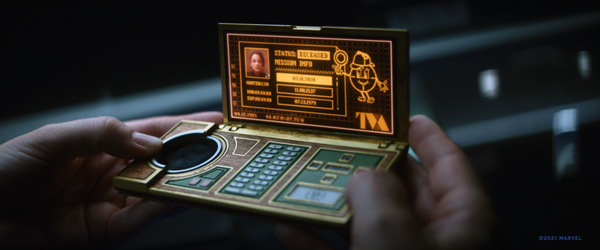
Setting the Tone
Discussions with Dan De Leeuw began in November 2020, sharing his wealth of MCU knowledge about the show with the team. As two critical storytelling constants in the series, the TemPad and Sacred Timeline visualisations were important to establish early on.
As an institution, the TVA command centre is far from a sleek, futuristic entity. Colour of choice is brown and the technological atmosphere is almost analogue, as if the digital transformation had passed it by. The employees work at large CRT monitors, and the Chronomonitors housing the Timeline screens positioned around the building have a rounded, organic design.
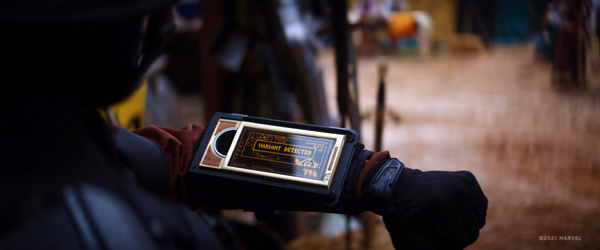
“Looks in the TVA itself feel more like the 1960s, while the screens we worked on were more aligned with the 1980s, so we used the Sacred Timeline to set the tone and vibe across the whole environment. We had some concepts, but time travel is always a challenge when trying to keep the audience in the plot. In the same way, the TemPad displays were always used to show everything about time in the story. Our job was to help complete the design and turn it into a device."
The Past, the Future and the TVA
The TVA exists in time irrelevant space, leaving to the artists the problem of representing the future and past consistently, while avoiding complexity. Stephen said, “The reason time travel cannot be used to prevent apocalypses is directly a result of the Nexus Events – that is, occurrences that the Time Variance Authority say are essential because they drastically alter history. Those events appear as Nexus points along the Timeline, both on the TemPads and on the screens inside the TVA, and are monitored to prevent the Sacred Timeline from breaking and allowing branches to deviate from it.”
Along with the show’s time travel theme, a sense of humour runs through the series. For example, when Loki enters the TVA for the first time and steps into the elevator he meets an awkward, retrostyled robot. It had been built and animated by Method Studios, but still needed a face to display in its monitor head. Cantina designed many variations for the face, eventually settling on a simple line design with a cathode-ray oscilloscope look created in Adobe After Effects and Illustrator. It smiles when it greets you and makes a confused face when it doesn’t understand something.
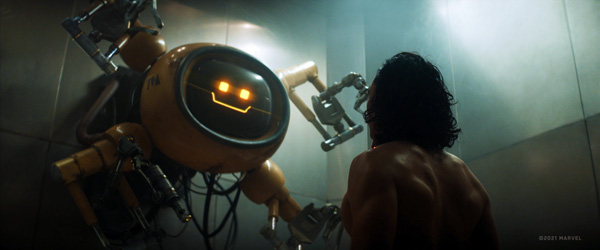
Design-Driven Pipeline
Cantina’s tools reflect their design-driven, motion graphics foundation. Adobe Creative Cloud software, especially After Effects, forms the basis of their pipeline. “But in fact we are tool agnostic and use whatever we need to get the look we want,” Stephen said. “Sometimes we’ll use Nuke for compositing but more often choose After Effects. Those decisions depend on the artist and the job. For 3D, Maxon Cinema 4D – including its workflow allowing you to import and use C4D files in After Effects – works well for us, and we use Cinema 4D or Maya for work that needs a photoreal finish, with 3D FX in Houdini."
The fact that Loki exists in many forms and versions is another story point that Cantina helped visualise. His alternate identities emerge at critical moments and often cause problems. At one point, TVA agent Mobius uses his TemPad to display multiple Loki variants that the Minutemen were hunting as a series of hologram timeline images and transitions. In effect, the audience watches Loki’s history pass by in holograms – Loki as soccer player, Loki as Barbarian, Loki the Asgardian, Loki as Tour de France competitor and so on – projected from Mobius’ TemPad as a visual storytelling technique.
“Our team worked with different Loki costumes and other 2D design assets the production’s art department supplied as Photoshop illustrations,” Stephen said. “Using After Effects, we animated and tracked all the final shots involving the holograms and composited them into the final scene so they felt as if they were floating in 3D space. Even so, creating them as 2.5D assets worked because we didn’t have to conform to rotating camera moves, which is why we could do the work in After Effects with Trapcode Particles and Trapcode Form.”
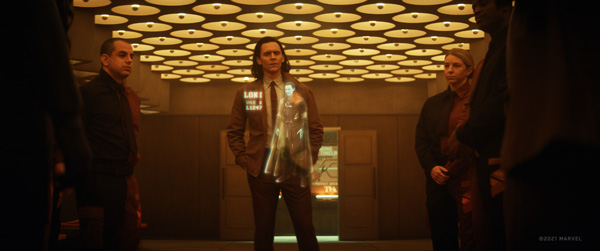
How Does It Work?
For Marvel, this kind of effect involved figuring out what the practicality of it would be, if it were real. How does it work? Is it a straightforward light-emitting projection device? What is the light source? Marvel wanted to figure out these details and also how it fit into the story, for example, where is the motivation for such a device coming from, where is it going? Does it need connections to other MCU stories?
Other MCU stories are referred to in the series in various subtle ways, such as in the animated display screen graphics for a tool the TVA Minutemen use date their timeline investigations, called quantum ore shovels. Those graphics needed to refer to other Marvel characters from outside ‘Loki’ itself.
When Loki shifts to a time in the near future, he ends up in a branch of a supermarket chain called Roxxcart. Cantina designed its logo as a straightforward device used in several iterations across various in-store screens. The work here included hologram designs for advertisements that appear on monitors throughout the Roxxcart superstore and on its CCTV security feeds, resulting in a look resembling ‘holographic TV’.
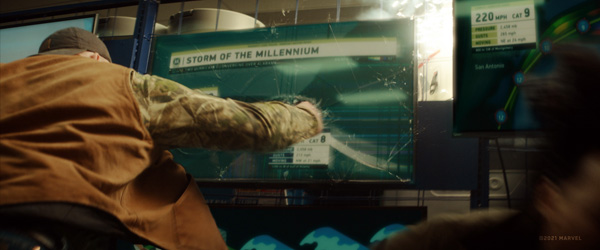
New Material
Possibly Cantina’s most interesting effects came toward the end of the series when Sylvie and Loki find their way into the castle of Kang, the mastermind behind the TVA. As he sits at his desk, telling them his backstory, he works with an amorphous, blob-like material, tossing it onto the desktop where it transforms into small sculptures of himself and other characters to illustrate different events.
Again, it was useful to consider the science behind how this process would work if it were real. Starting with a LiDAR scan of Kang, they created some postvis still frame poses. “We applied a 2D/3D approach,” said Stephen. “Our material, which we called ‘flubber’, had a texture between liquid and solid that we animated and used to create CG sculpts. Then, using Houdini, we created a simulation between the poses.
“The development of that material led to considering what materials would traverse time for Kang to take with him from the past. Light, perhaps, since light behaviour allows light to reach us from a long time away? Our team looked into some research NASA had done on light to see what could be applied to the sequence. The audience sees the material morphing into a solid, which meant each pose had to be readable but remain light-based.”

The End
Andrew Hawryluk said, “We were challenged to get the behaviour of the Houdini particle simulations just right to make sure they had properties of both solids and liquids. The material also had purple-gold marbling, recalling the castle and surfaces in the room the characters occupy. As the figures formed and re-formed we needed to continuously match the flickering lighting coming in the window, and add a rimlight to integrate the sculptures with the desktop and make them feel physical. Exporting EXR’s from Houdini allowed us to integrate the on-set lighting and the CG renders for compositing.”
Cantina also contributed to the final appearance of the giant all-consuming purple cloud, Alioth, that guards the void where all variants are eventually sent to be swallowed up. The team’s task was to develop a simulation that gave the cloud a more solid form so that it could take shape as a creature. After they received concepts for this effect from ILM, who had been working on Alioth’s more gaseous state, the challenge was to avoid giving it a brain-like appearance, often a risk for designers when changing elements from a gaseous to a solid state. cantinacreative.com


















